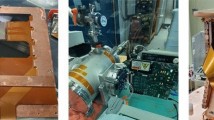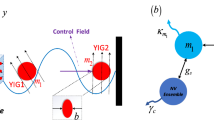Abstract
The microwave SQUID multiplexer (μmux) has enabled higher bandwidth or higher channel counts across a wide range of experiments in particle physics, astronomy, and spectroscopy. The large multiplexing factor coupled with recent commercial availability of microwave components and warm electronics readout systems make it an attractive candidate for systems requiring large cryogenic detector counts. Since the multiplexer is considered for both bolometric and calorimetric applications across several orders of magnitude of signal frequencies, understanding the bandwidth of the device and its interaction with readout electronics is key to appropriately designing and engineering systems. Here, we discuss several important factors contributing to the bandwidth properties of \(\mu\)mux systems, including the intrinsic device bandwidth, interactions with warm electronics readout systems, and aliasing. We present simulations and measurements of \(\mu\)mux devices coupled with SLAC Microresonator RF (SMuRF) tone-tracking electronics and discuss several implications for future experimental design.





Similar content being viewed by others
Data Availability
The datasets used to generate the plots and conclusions in these proceedings are available from the corresponding author on reasonable request.
References
A. Cukierman et al., Microwave multiplexing on the Keck array. J. Low Temp. Phys. 199, 858–866 (2020). https://doi.org/10.1007/s10909-019-02296-2
N. Galitzki et al., The Simons Observatory: instrument and overview. Proc. SPIE 10708, 1070804 (2018). https://doi.org/10.1117/12.2312985
The Lynx Team, The Lynx Mission Concept Study Interim Report (2018). ar**v:1809.09642
J.A.B. Mates et al., Simultaneous readout of 128 X-ray and gamma-ray transition-edge microcalorimeters using microwave SQUID multiplexing. Appl. Phys. Lett. 111, 062601 (2017). https://doi.org/10.1063/1.4986222
D.A. Bennett et al., Microwave SQUID multiplexing for the Lynx x-ray microcalorimeter. J. Astron. Telesc. Instrum. Syst. 5(2), 021007 (2019). https://doi.org/10.1117/1.JATIS.5.2.021007
A. Puiu et al., Updates on the transition-edge sensors and multiplexed readout for HOLMES. J. Low Temp. Phys. 193, 1167 (2018). https://doi.org/10.1007/s10909-018-1950-z
S.W. Henderson et al., Highly-multiplexed microwave SQUID readout using the SLAC microresonator radio frequency (SMuRF) electronics for future CMB and sub-millimeter surveys. Proc. SPIE 10708, 1070819 (2018). https://doi.org/10.1117/12.2314435
K.D. Irwin, K.W. Lehnert, Microwave SQUID multiplexer. Appl. Phys. Lett. 85, 2107 (2004). https://doi.org/10.1063/1.1791733
J.A.B. Mates, G.C. Hilton, K.D. Irwin, L.R. Vale, K.W. Lehnert, Demonstration of a multiplexer of dissipationless superconducting quantum interference devices. Appl. Phys. Lett. 92, 023514 (2008). https://doi.org/10.1007/s10909-012-0518-6
M. Wegner, N. Karcher, O. Krömer, D. Richter, F. Ahrens, O. Sander, S. Kempf, M. Weber, C. Enss, Microwave squid multiplexing of metallic magnetic calorimeters: status of multiplexer performance and room-temperature readout electronics development. J. Low Temp. Phys. 193, 462 (2004). https://doi.org/10.1007/s10909-018-1878-3
B. Dober et al., A microwave SQUID multiplexer optimized for bolometric applications. Appl. Phys. Lett. 118, 062601 (2021). https://doi.org/10.1063/5.0033416
The CMB-S4 Collaboration, CMB-S4 Technology Book (2017). ar**v:1706.02464
S. Gordon et al., An open source, FPGA-based LeKID readout for PLAST-TNG: pre-flight results. J. Astron. Instrum. (2016). https://doi.org/10.1142/S2251171716411038
N. Fruitwala et al., Second generation readout for large format photon counting microwave kinetic inductance detectors. Rev. Sci. Instrum. 91, 124705 (2020). https://doi.org/10.1063/5.0029457
J.A.B. Mates, The microwave SQUID multiplexer. PhD thesis (2011). ISBN:978-1-124-62108-1
L. Moncelsi et al., Receiver development for BICEP array, a next-generation CMB polarimeter at the South Pole. Proc. SPIE 11453, 1145314 (2020). https://doi.org/10.1117/12.2561995
M. Salatino et al., The design of the Ali CMB polarization telescope receiver. Proc. SPIE 11453, 114532A (2020). https://doi.org/10.1117/12.2560709
M. Sandberg, C.M. Wilson, F. Persson, T. Bauch, G. Johansson, V. Shumeiko, T. Duty, P. Delsing, Tuning the field in a microwave resonator faster than the photon lifetime. Appl. Phys. Lett. 92, 203501 (2008). https://doi.org/10.1063/1.2929367
J. Zmuidzinas, Superconducting microresonators: physics and applications. Annu. Rev. Condens. Matt. Phys. 3, 169–214 (2012). https://doi.org/10.1145/annurev-conmatphys-020911-125022
J.S. Gao, J. Zmuidzinas, B.A. Mazin, H.G. Leduc, P.K. Day, Noise properties of superconducting coplanar waveguide microwave resonators. Appl. Phys. Lett. 90, 102507 (2007). https://doi.org/10.1063/1.2711770
C. Yu, et al. SLAC microresonator RF (SMuRF) electronics: a tone-tracking readout system for microwave resonator-based cryogenic detector arrays (in prep)
Acknowledgements
The authors thank Kent Irwin for useful discussions. CY was supported in part by the National Science Foundation Graduate Research Fellowship Program under Grant No. 1656518.
Author information
Authors and Affiliations
Corresponding author
Additional information
Publisher's Note
Springer Nature remains neutral with regard to jurisdictional claims in published maps and institutional affiliations.
Rights and permissions
About this article
Cite this article
Yu, C., Ahmed, Z., Connors, J.A. et al. Bandwidth and Aliasing in the Microwave SQUID Multiplexer. J Low Temp Phys 209, 589–597 (2022). https://doi.org/10.1007/s10909-022-02783-z
Received:
Accepted:
Published:
Issue Date:
DOI: https://doi.org/10.1007/s10909-022-02783-z




